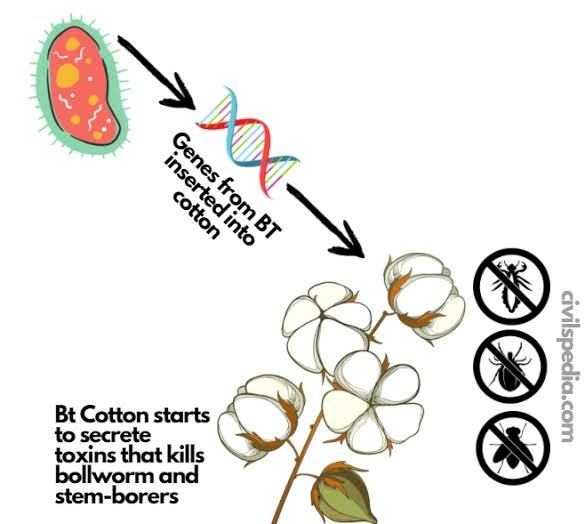LOSING THE THREAD: INDIA’S COTTON CRISIS
Syllabus:
GS-3:
- Major crops and cropping patterns .
- Issue in agriculture.
Why in the News?
- India, once the world’s leading cotton producer and a major exporter, is now importing more cotton than it exports.
- The lack of technological adoption, regulatory hurdles, and an irrational aversion to GM crops have led to this decline, forcing India to depend on American, Australian, and Brazilian cotton.
The Rise and Fall of India’s Cotton Industry
India’s cotton industry witnessed remarkable growth due to technological innovations but is now experiencing a sharp decline.
- Technological boost (2002-2013) – The adoption of Bt cotton hybrids, coupled with high-yielding hybrid varieties, helped triple cotton production from 6 mb to 39.8 mb in just a decade.
- Export dominance (2011-2014) – By 2011-12, India became the second-largest cotton exporter, and by 2015-16, the world’s top producer.
- Gradual decline post-2014 – Production started falling after 2013-14, with national lint yields dropping from 566 kg per hectare to below 450 kg by 2024-25.
- Rising imports, falling exports – India has become a net importer, with cotton imports projected to double in value from $518.4 million to $1.04 billion in 2024-25.
- Loss of global competitiveness – The lack of new technology approvals has made Indian cotton less productive, allowing US, Brazil, and Australia to capture India’s market share.
How Technology Transformed Cotton Production
India’s past success in cotton was driven by scientific advancements, but policy paralysis has halted further innovations.
- Pioneering hybrid varieties – Scientists like T. Patel and B.H. Katarki developed world’s first cotton hybrids (H-4 and Varalaxmi), significantly increasing yields.
- Introduction of Bt cotton (2002) – The commercialization of Bt cotton, genetically modified to resist pests, led to widespread adoption, covering 95% of India’s cotton area by 2013-14.
- Boost in yields – Before Bt cotton, average lint yield was 127-302 kg per hectare; after Bt adoption, it jumped to 566 kg per hectare by 2013-14.
- Second-generation Bollgard-II (2006) – A more advanced version, Bollgard-II, provided resistance against multiple pests, further improving productivity.
- No new approvals since 2006 – Despite rising threats like pink bollworm, no new GM cotton varieties have been approved, stagnating productivity growth.
Regulatory Blockade and Policy Paralysis
India’s restrictive policies on GM crops have led to a decline in cotton productivity while benefiting global competitors.
- Moratorium on GM crops (2010) – The UPA government banned GM Bt brinjal, overruling scientific recommendations and giving in to activist pressure.
- Field trials halted under NDA – The NDA government further blocked GM crop trials, treating them as hazardous substances under the Environment Protection Act, 1986.
- Regulatory deadlock – No new GM cotton hybrids have been approved since Bollgard-II in 2006, leaving farmers with outdated technology.
- Delayed approvals for indigenous innovations – High-yield GM mustard from Delhi University and pest-resistant cotton from Lucknow-based NBRI have struggled with approvals.
- Courts interfering in science – Judicial interventions have further stalled scientific advancements, leading to a total regulatory gridlock in GM crop approvals.
Impact on Farmers and the Economy
The refusal to embrace new technologies has worsened cotton productivity, harming farmers and India’s agricultural economy.
- Rising pest attacks – The pink bollworm, which emerged in 2014, has devastated cotton yields, worsening India’s production crisis.
- Higher import dependence – India’s cotton imports have doubled, making the country reliant on US, Brazilian, and Australian cotton.
- Farmers losing competitive edge – Indian farmers are forced to use outdated seeds, while global competitors benefit from advanced GM crops.
- Pressure to lower import duties – The US and Brazil are pushing India to remove the 11% import duty on cotton, further reducing farmer protections.
- Contradiction in policy – India allows imports of GM soybean meal and corn but denies Indian farmers access to GM cotton and mustard, creating an uneven playing field.
Way Forward: Reviving India’s Cotton Industry
To regain its lost status as a cotton leader, India must embrace scientific advancements and regulatory reforms.
- Approve new GM cotton varieties – The government must immediately approve Bollgard-III and other advanced GM hybrids to tackle pest resistance.
- Reform the regulatory framework – The Genetic Engineering Appraisal Committee (GEAC) should be made independent and free from political influence.
- Encourage scientific decision-making – Public consultations should be based on scientific evidence, not activist-driven fears.
- Promote indigenous innovations – Indigenous GM mustard and pest-resistant cotton varieties must be fast-tracked for approval.
- Protect farmers from unfair competition – The government must resist pressure to lower import duties on cotton while denying Indian farmers access to new technology.
Conclusion
India’s cotton crisis is self-inflicted, driven by policy inaction and an unscientific aversion to GM crops. Once the world’s top producer, India is now importing more than it exports, benefiting global cotton giants like the US and Brazil. To reverse this decline, India must embrace technological advancements, streamline regulatory approvals, and protect farmer interests. The choice is clear—either adapt and regain leadership or continue losing the thread.
Source: Indian Express
Mains Practice Question
Discuss the factors responsible for the decline of India’s cotton production and its transition from a net exporter to a net importer. How can policy reforms and technological advancements help revive the cotton industry? (250 words)






